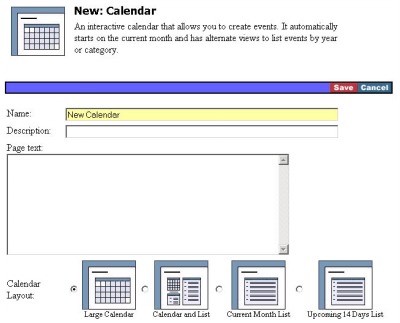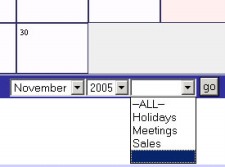261 Broad Street
Windsor, CT 06095
(860) 285-0172
support@invisiblegold.com
Your Website Should Be Easy to Edit
Windsor, CT 06095
(860) 285-0172
support@invisiblegold.com
Your Website Should Be Easy to Edit
Calendar
Categories
Set the categories by clicking Edit on the calendar page. Scroll down to the bottom and type one category per line. Note: Be careful to choose the right spelling and name. If you change the spelling later, it won't automatically update all of the events with the new category name. Once you set a list of categories for the calendar, every new event you add will include a category list to choose from. |
Creating Events
Events have a name and a description. The name is what shows up on the calendar. The description is what shows up on the list of events under the name. Each event also has a start day and an option to span more than one day (duration). If you choose 'custom end date,' there will be an option to also choose the end date. The category option lets you group events so visitors can view one category at a time if they choose to. The category shows up in the list layouts for the calendar in bold. Once you save an event, you also have the option to click NEW and create subpages. This can be useful for creating signup sheets (products or custom templates), or add photos (slideshow) from a past event. |
Deleting Past Events
To make deletion automatic, click Edit on the calendar page and scroll to the bottom. Check the box for automatically deleting past events and click save. Every day after midnight, past events will be deleted. To manually delete past events, simply click the red button DELETE PAST EVENTS. They will be deleted immediately. |
Special Options
Another option is to display calendar events automatically on other parts of the site. For more information talk to your website designer or visit the authoring section of this manual. On the right is an example of a calendar event. The upcoming 10 days of events are shown in the right side of every page of this website. The layout of the right side navigation bar has been compressed to fit the small space. |
See Also:
| Online Documentation Home, Invisible Gold Quick Tour, Template Library, Users and Groups, Shopping Cart, Mailing Lists, Uploading Images, Traffic, Approvals, Banner Ads, Login/Logout, Email Newsletters, Advanced Button, Moving Pages, System View, Security, System Settings, Hosting Invisible Gold Powered Websites, Generate a PayPal Client ID, Terms, Useful HTML Guide, Private Client Areas |
Keywords:
| Templates, Calendar |





